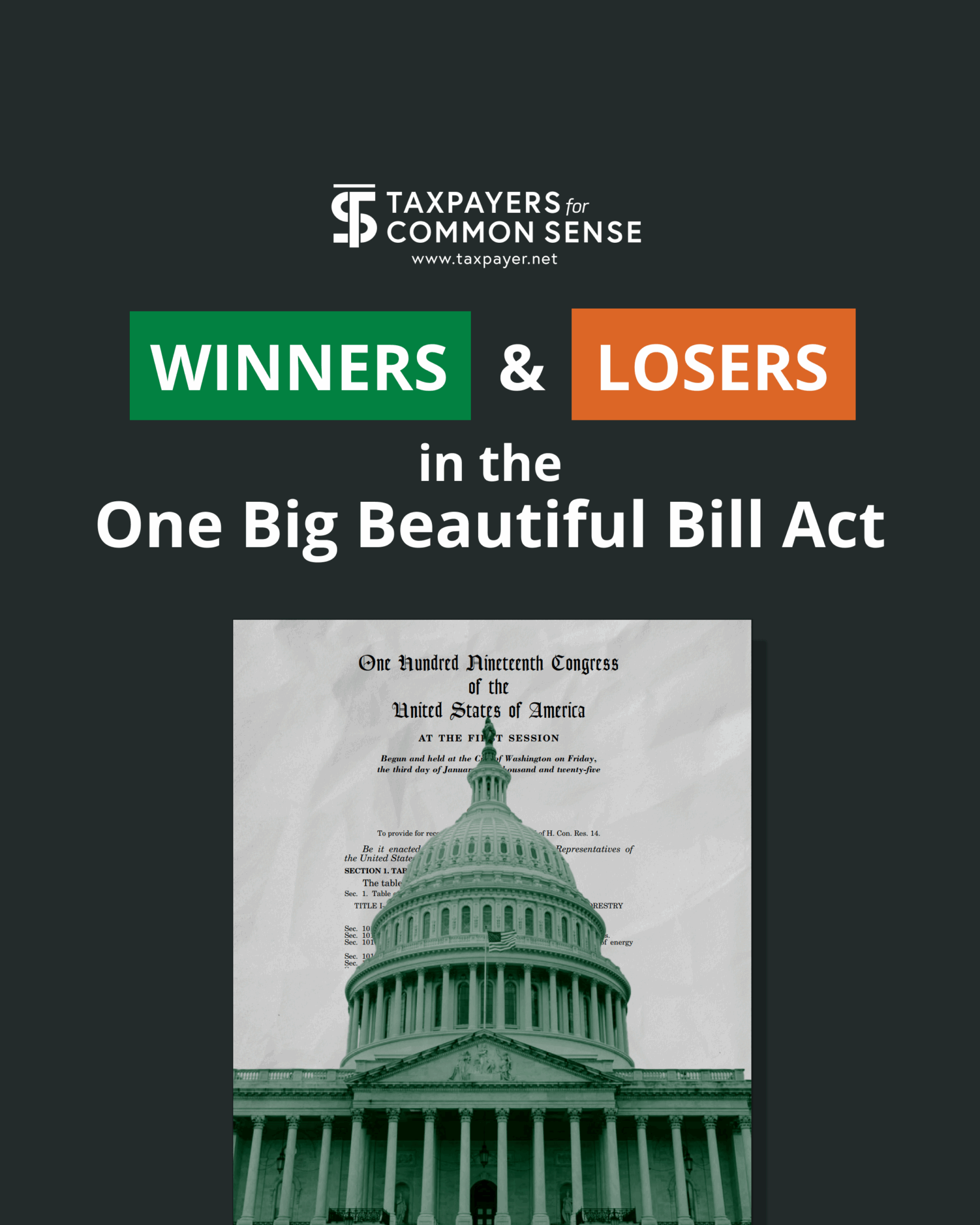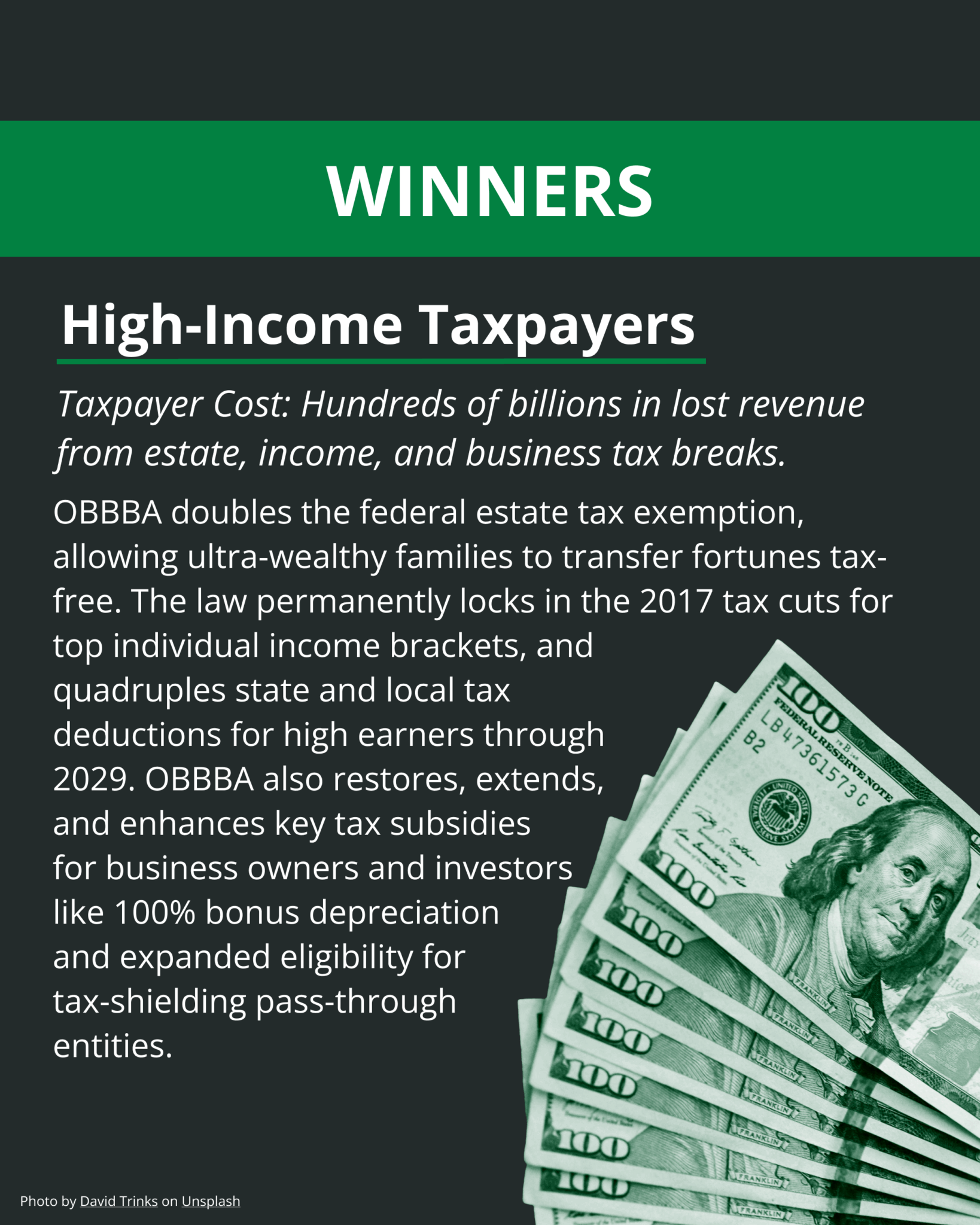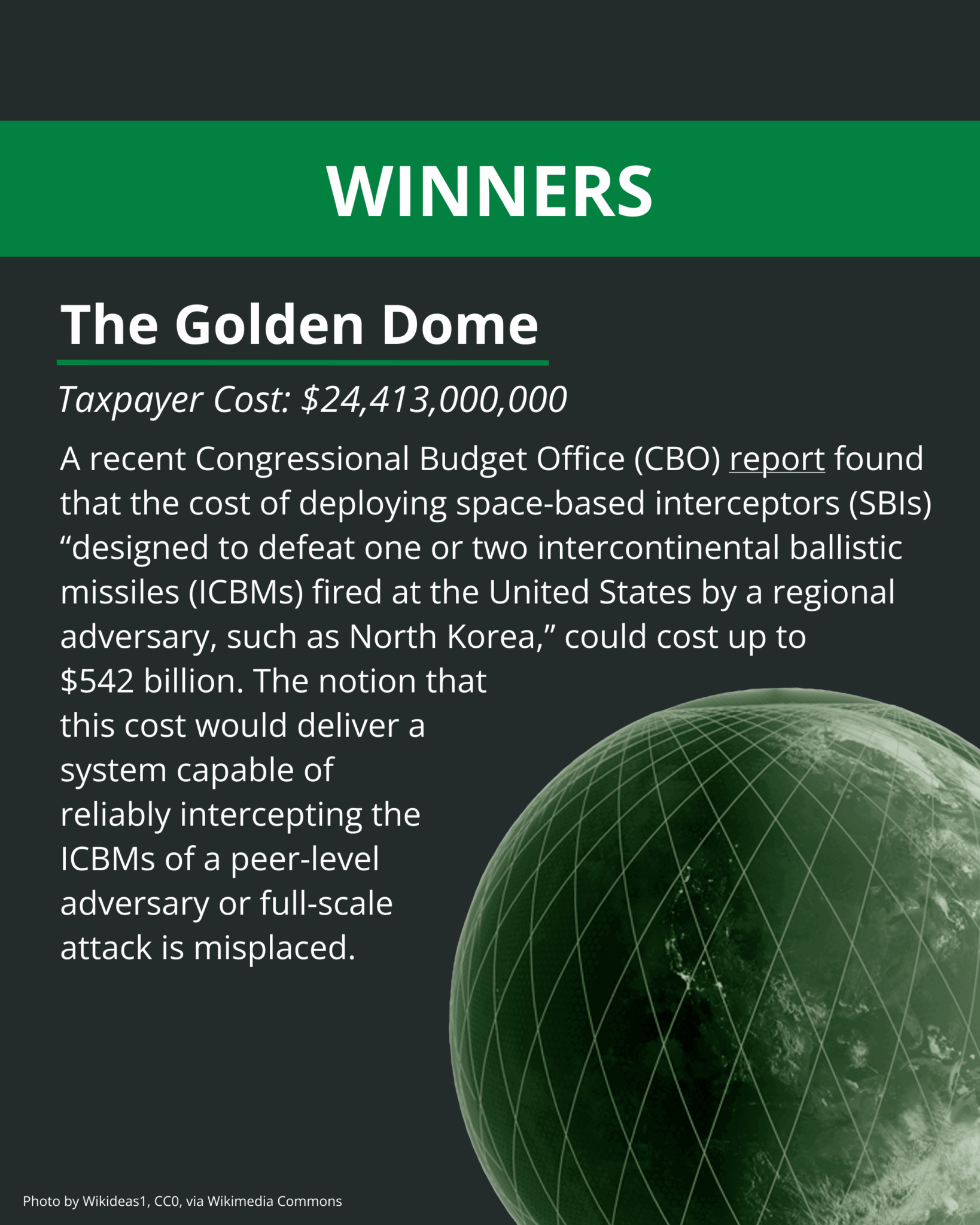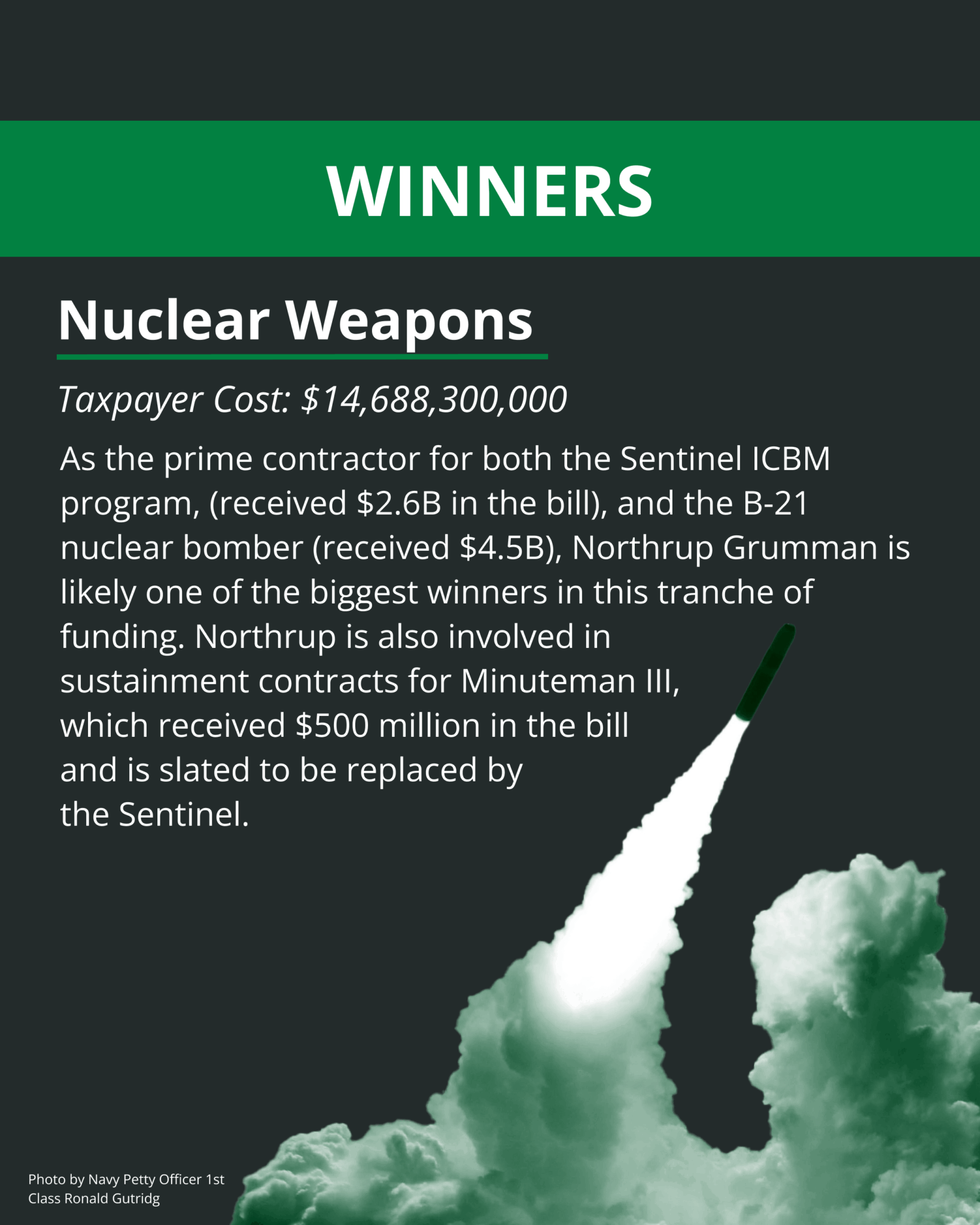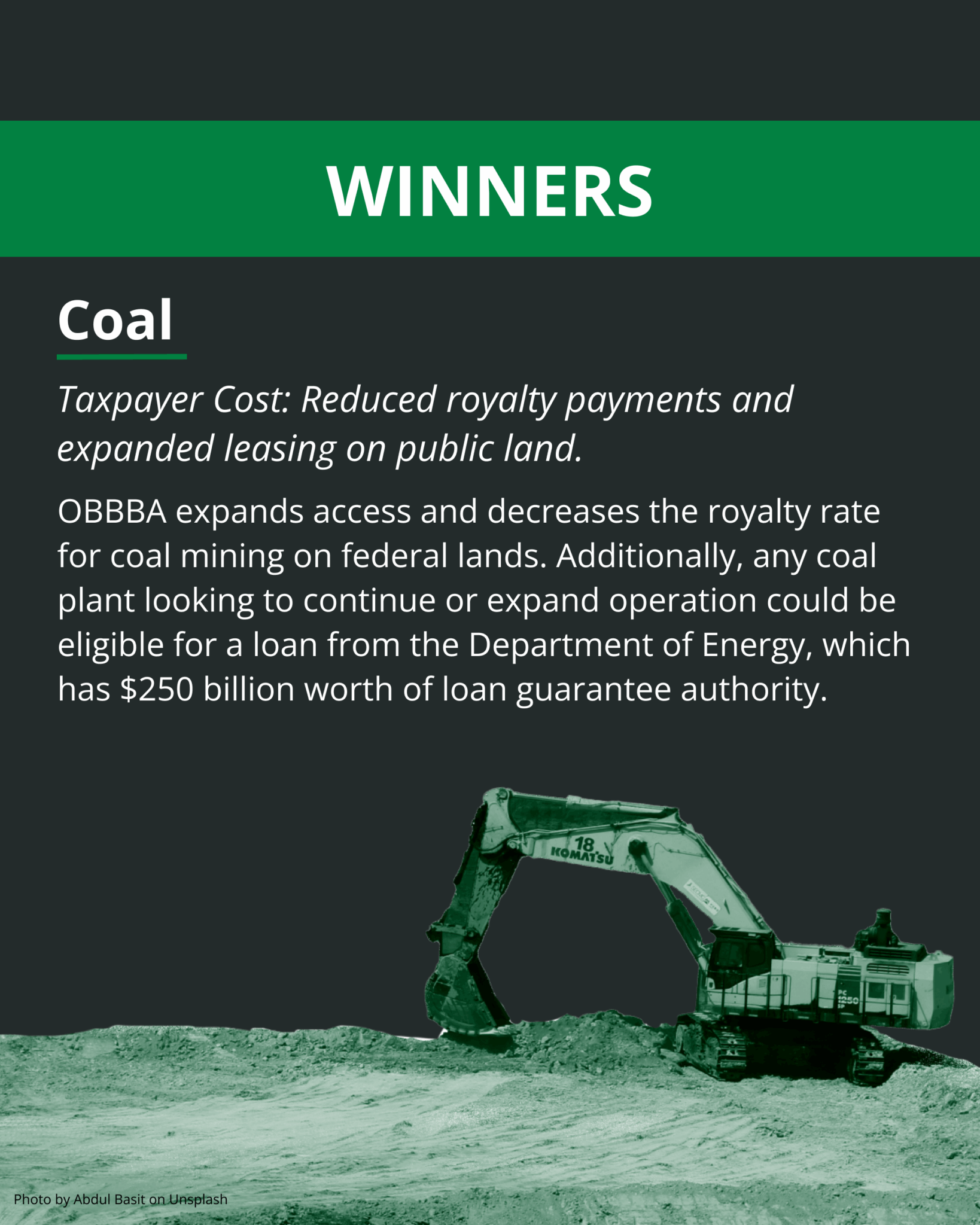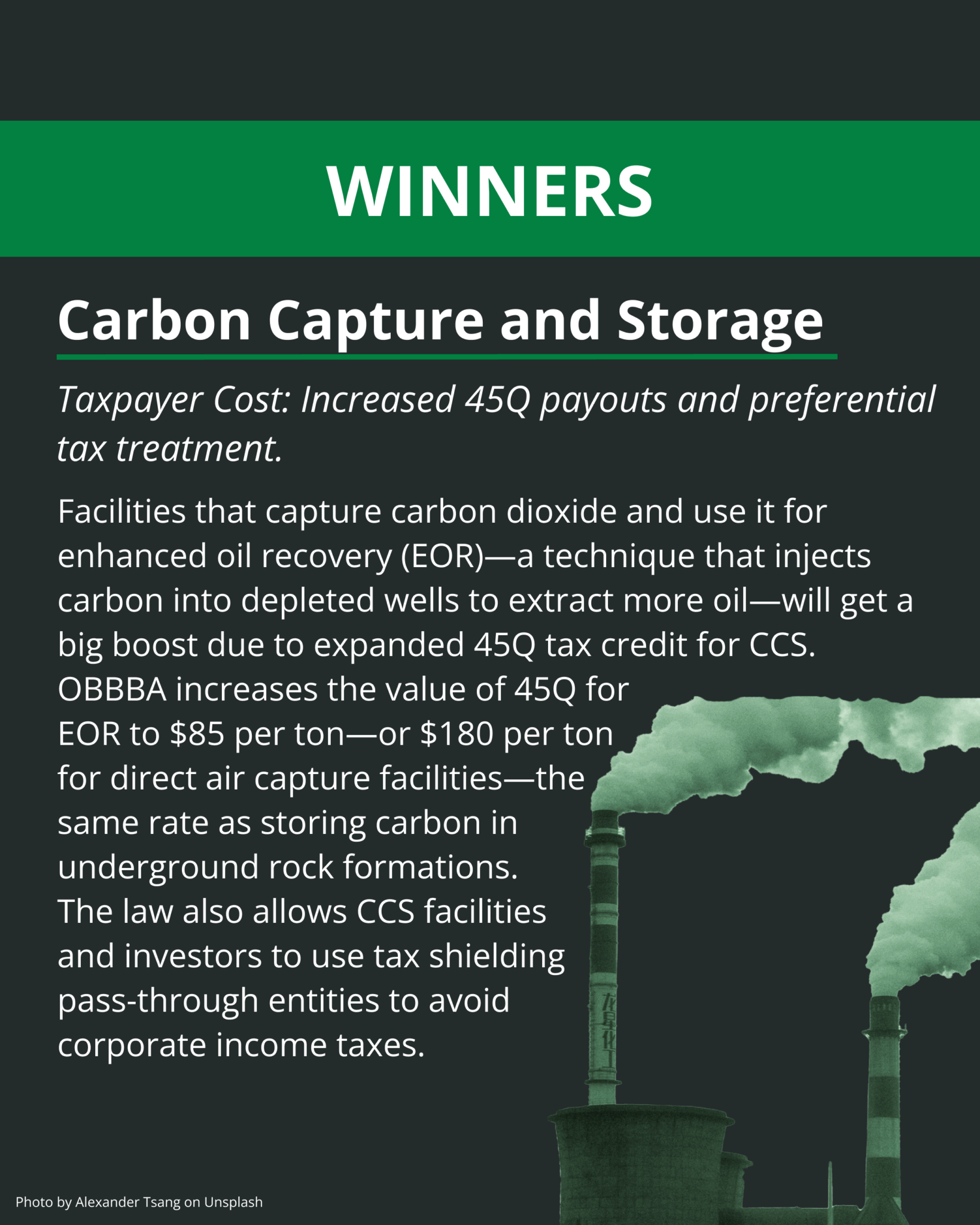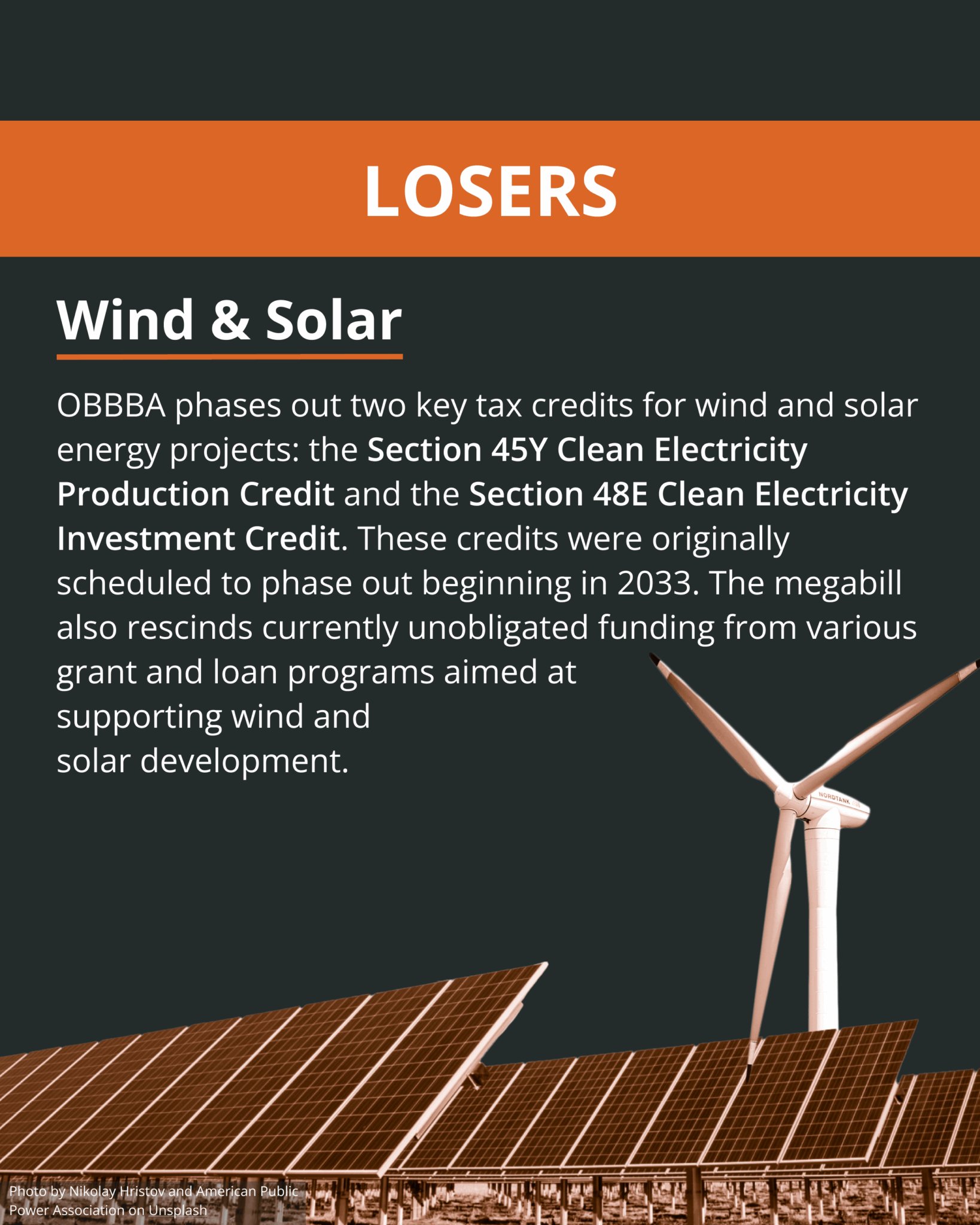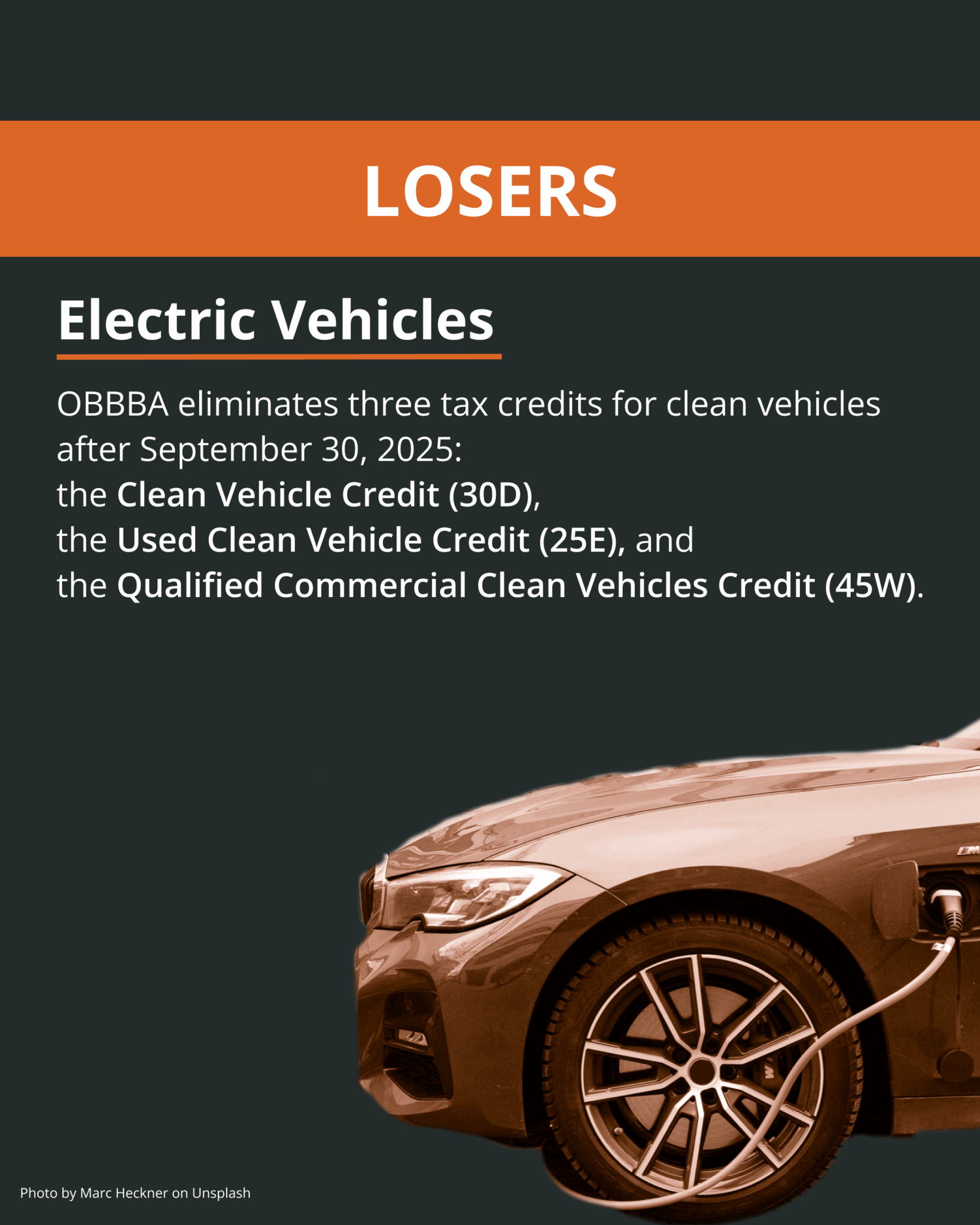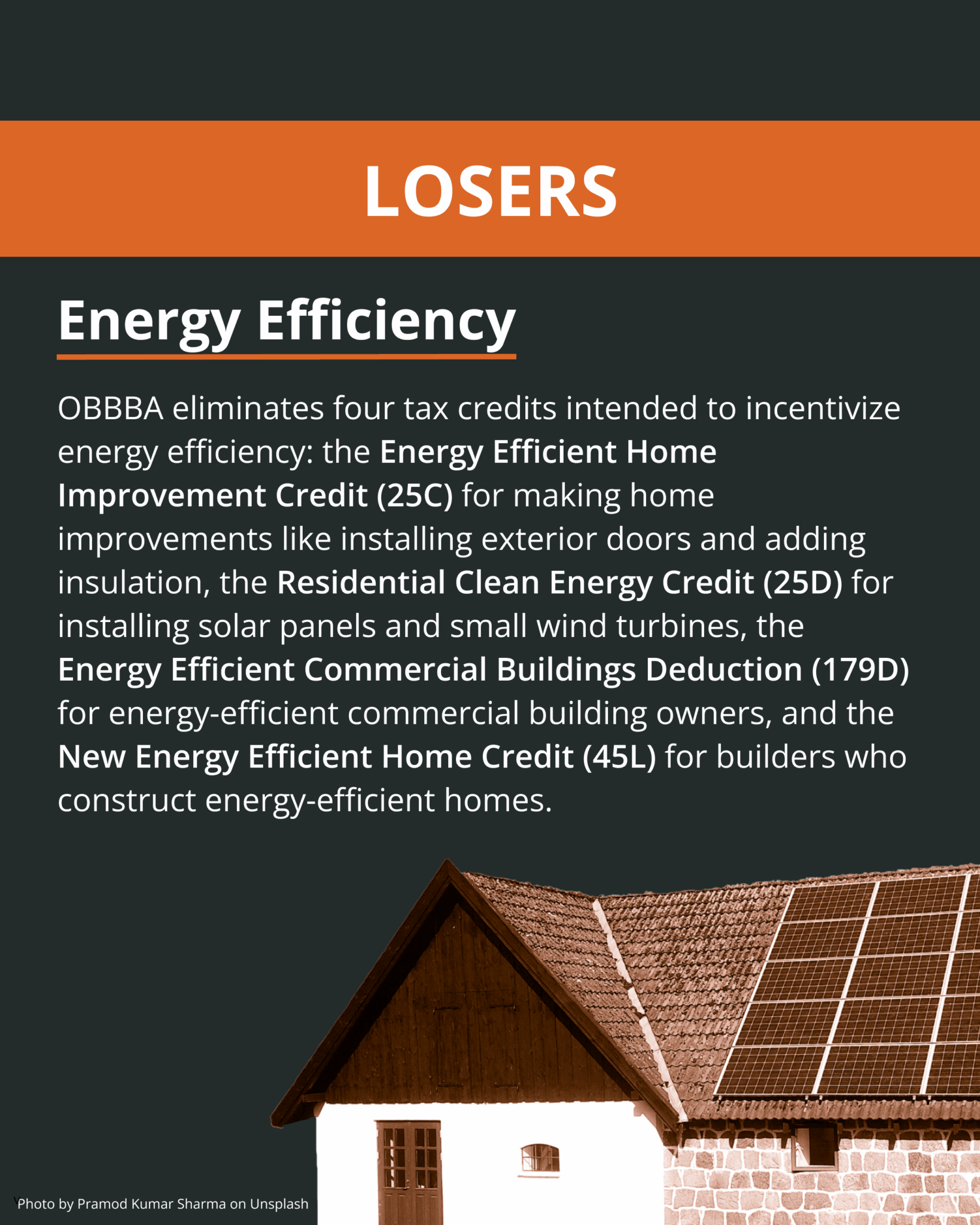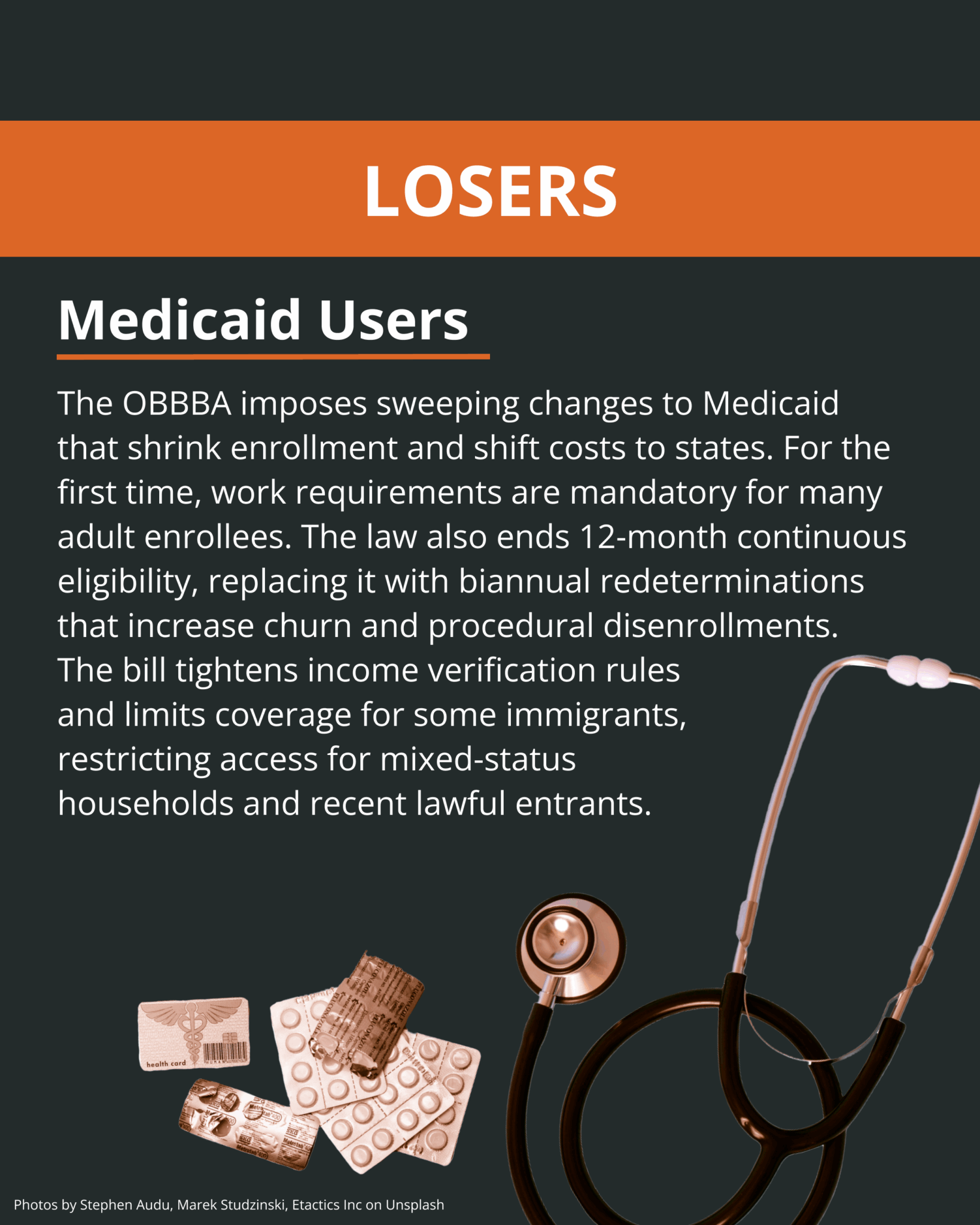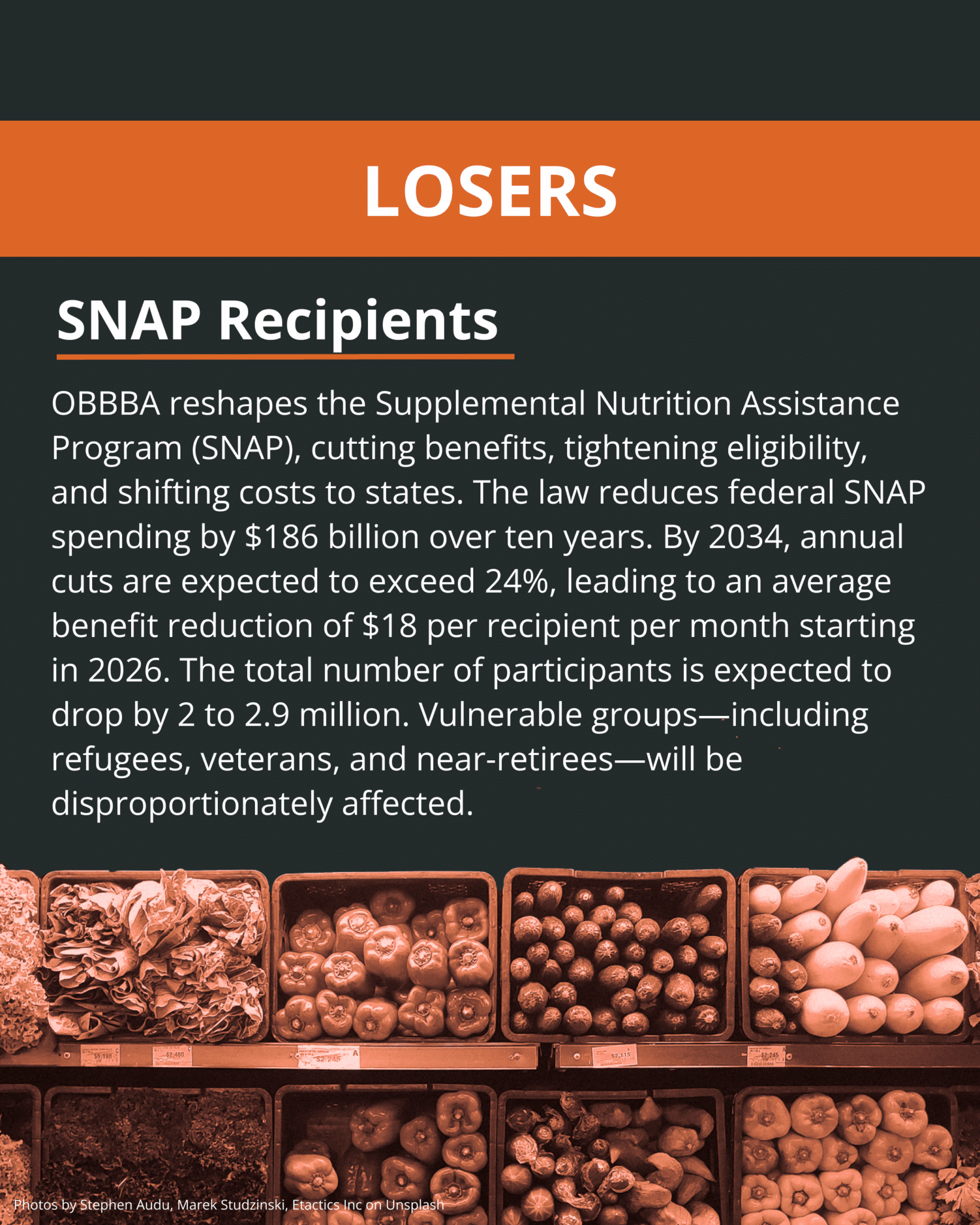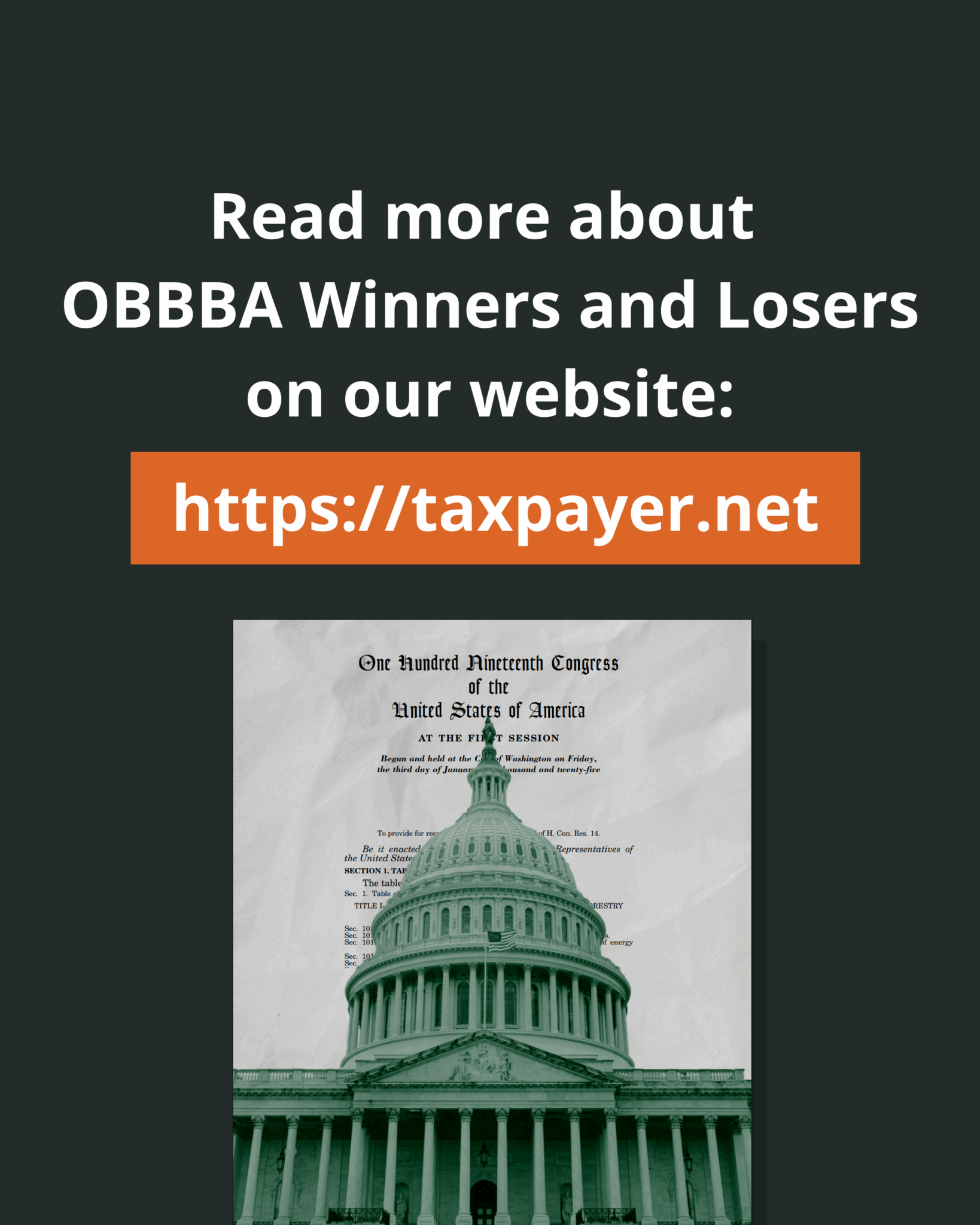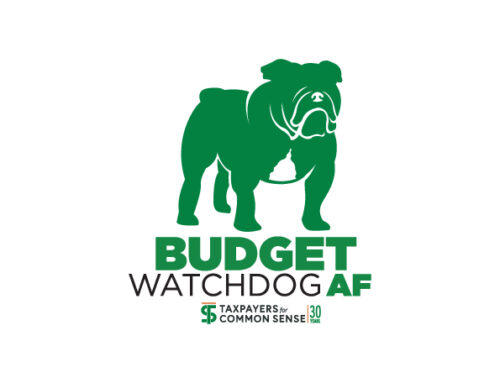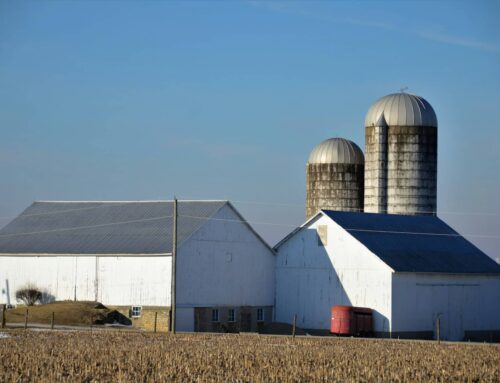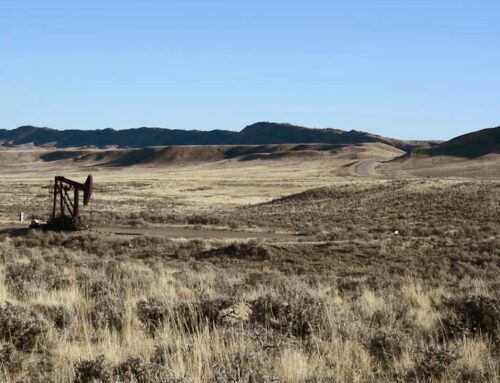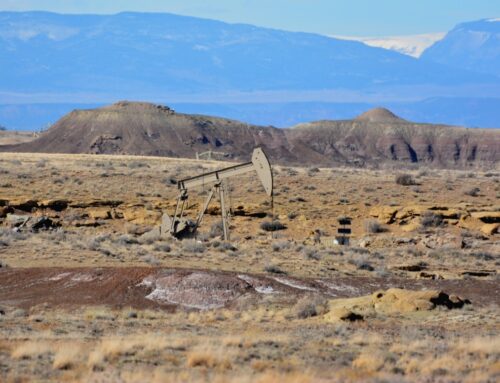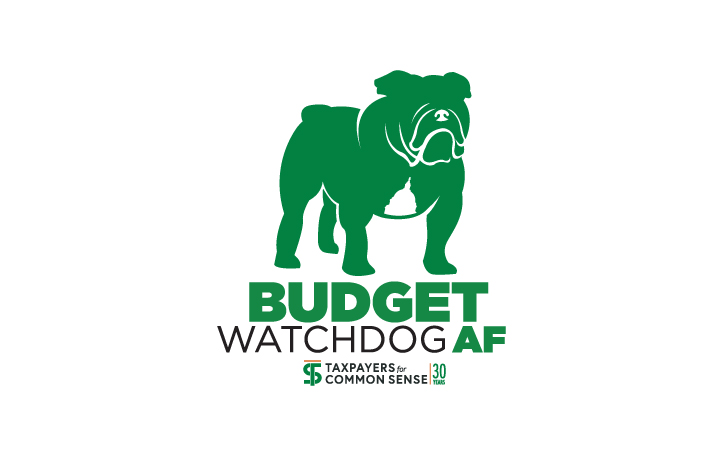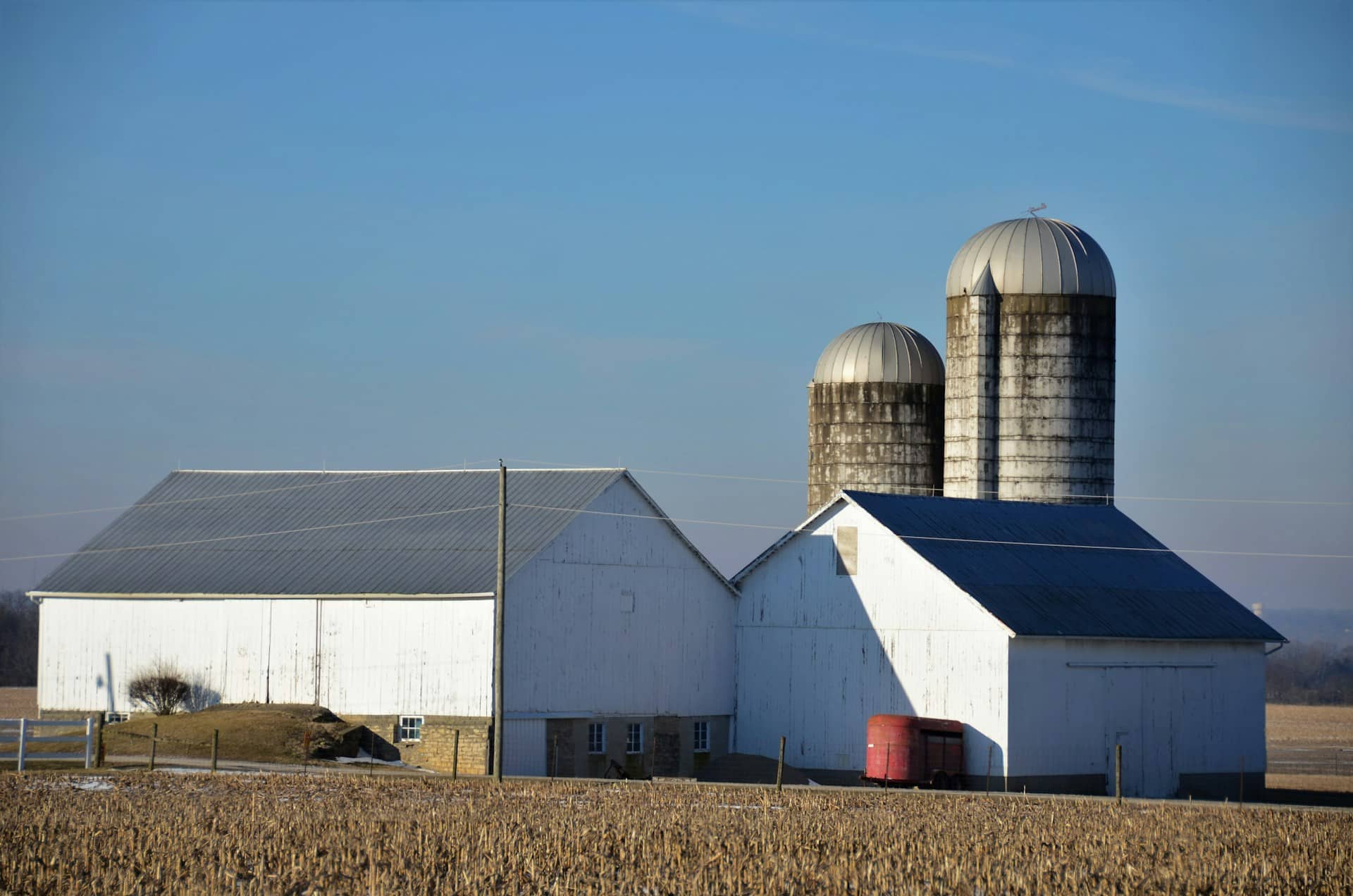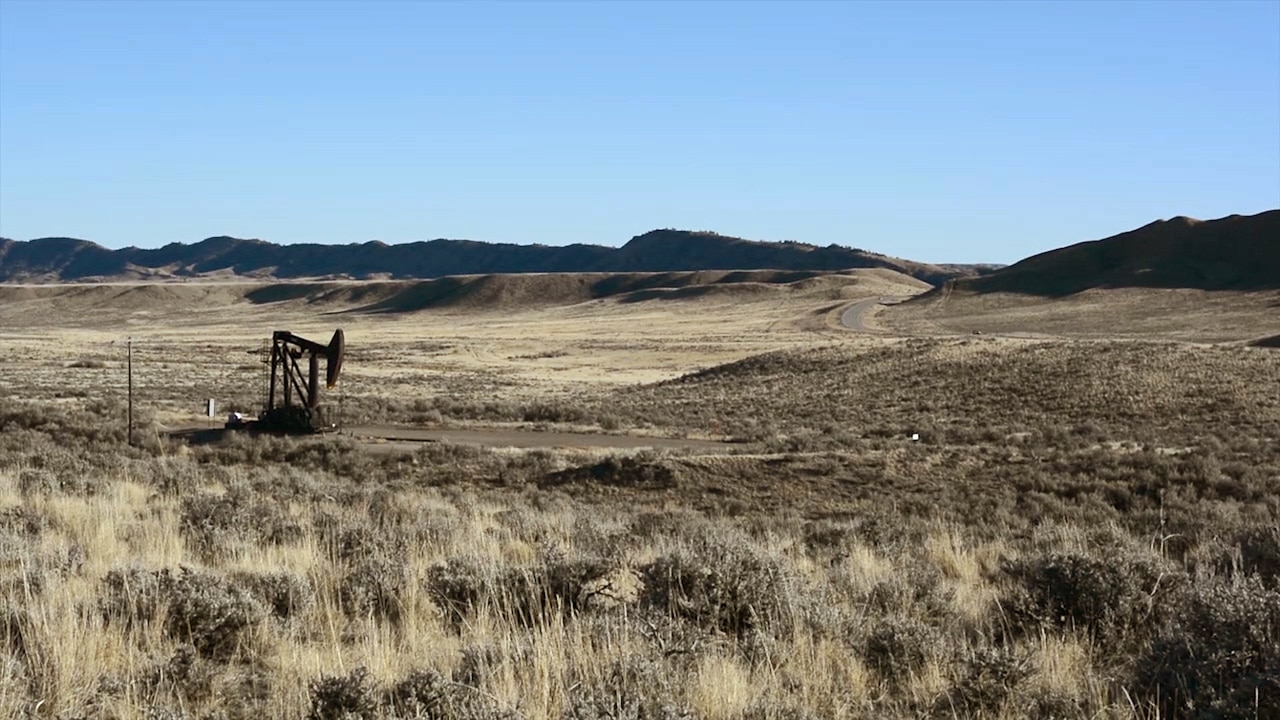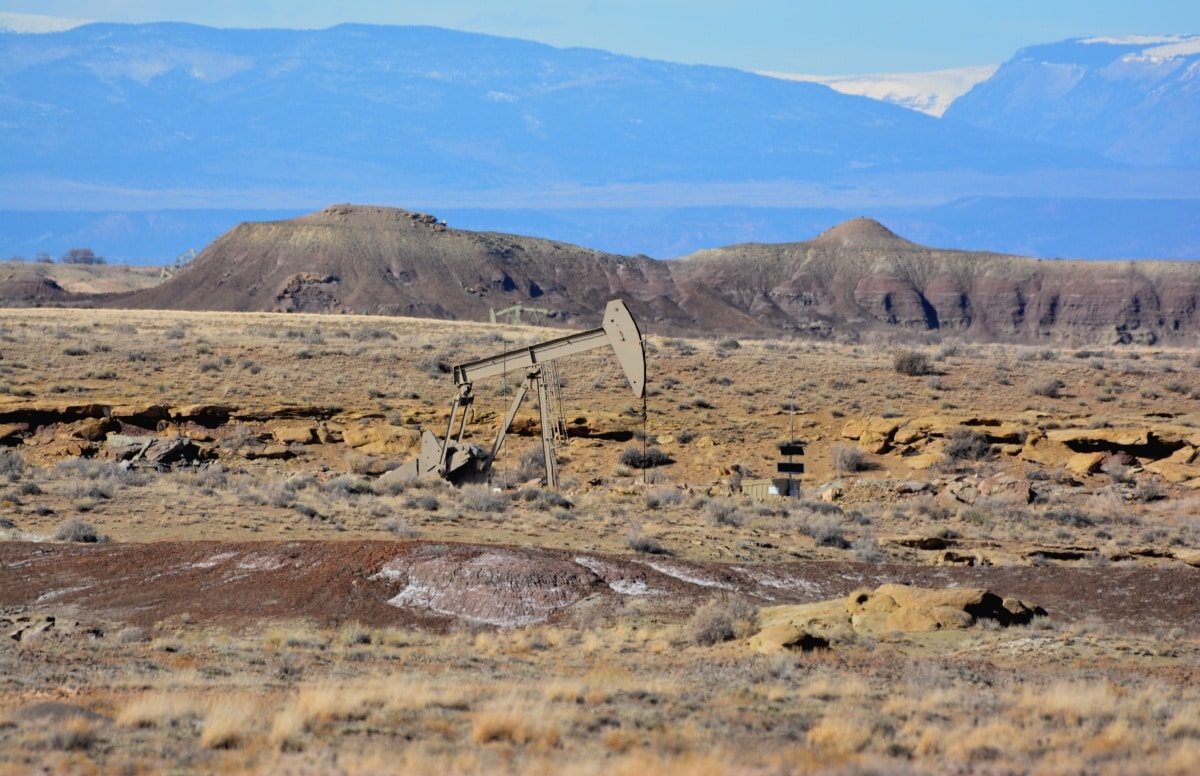The One Big Beautiful Bill Act (OBBBA) stands as one of the most fiscally consequential pieces of legislation in recent memory, fundamentally reshaping federal spending priorities and tax policy across dozens of sectors. The massive package, which adds $3.4 trillion to federal deficits over the next decade before accounting for interest costs, exemplifies how Congress can use sweeping reconciliation bills to advance narrow interests at the expense of fiscal responsibility.
Marketed as essential for economic growth and national security, OBBBA primarily benefits wealthy individuals, established industries, and well-connected special interests. It permanently extends tax cuts for high earners, dramatically expands subsidies for already-profitable fossil fuel and agriculture industries, and pours tens of billions into new defense contracts, while slashing social safety net programs and eliminating incentives for emerging clean energy sectors.
What follows is a breakdown of the winners and losers in OBBBA. By cataloguing the bill’s specific provisions and their costs, we aim to provide taxpayers with the transparency they deserve about how their government spends their money.
The Winners
High-Income Taxpayers
Taxpayer Cost: Hundreds of billions in lost revenue from estate, income, and business tax breaks.
OBBBA delivers a suite of permanent and long-term tax advantages for high earners, expanding their ability to shield income and wealth from federal taxes. The bill doubles the federal estate tax exemption to $15 million per person ($30 million per couple), allowing ultra-wealthy families to transfer vast fortunes tax-free.
Top-bracket individual income tax cuts, first enacted in 2017, are made permanent—locking in lower rates and delivering the largest dollar benefits to the highest-income households.
For business owners and investors, the bill locks in the 20% deduction for pass-through income (Section 199A) and restores the full bonus depreciation, both of which reduce effective tax rates for those with large profits and capital reserves. Expanded eligibility for publicly traded partnerships (PTPs) and continued favorable treatment of pass-through entities further enhance tax sheltering opportunities. The cap on state and local tax (SALT) deductions is temporarily raised from $10,000 to $40,000 through 2029 for those earning up to $400,000—delivering targeted relief to upper-middle and high-income residents in high-tax states.
High-income taxpayers also stand to benefit indirectly from OBBBA’s industry subsidies. Massive new spending on defense, fossil fuels, and biofuels boosts the value of corporate holdings and pass-through income streams tied to these sectors—benefiting owners, investors, and shareholders.
Artificial Intelligence
Taxpayer Cost: $1.5 billion on AI development in federal agencies.
The bill provided $150 million for the Department of Energy (DOE) to develop artificial intelligence models and make them available to the scientific community on top of $1.4 billion for various DOD-related AI activities. In a possible setback to AI firms, the final bill stripped a provision from the original House draft thatwould have implemented a 10-year moratorium on state-level regulation of artificial intelligence models and systems entered into interstate commerce.
Already Highly Subsidized Farmers
Taxpayer Cost: $67 billion in increased Farm Bill spending.
The bill plants nearly $70 billion in increased spending across a variety of federal farm programs normally authorized in a Farm Bill. The biggest cost comes from increases in government guaranteed minimum crop prices for a range of row crops (such as corn, cotton, wheat, and rice) by 11% to 21%, depending on the crop. A related provision allows farmers to enroll 30 million new acres into these programs. The Price Loss Coverage (PLC) program alone is expected to result in $50 billion in additional farm income subsidies, with especially generous checks for rice, cotton, and peanut growers.
Agricultural Accountants, Lawyers, and Lobbyists
Taxpayer Cost: $2 billion+ from exploiting loopholes to avoid payment limits
The Agriculture section of OBBBA will be a boon to individuals who help farm operations maximize their payouts from federal programs. Lawmakers increased the limit an individual farmer can receive annually from farm subsidy programs from $125,000 to $155,000 and set the limit to increase annually with inflation. A loophole that previously allowed farms structured as “joint ventures” or “partnerships” to treat limits on payments at each partner’s level, as opposed to the whole operation, was expanded to include all partnerships, S Corporations, and LLCs.
At the same time, the bill weakens a 40-year-old rule that prevented farm subsidies from going to operations or individuals who earn more than $900,000 in adjusted gross income annually. Now any farmer or farm operation, whether their income is $100,000 or $100,000,000, can receive farm subsidies as long as they make at least 75% of their income from farming, ranching, or “similar activities.” The bill leaves the definition of “similar activities” up to the Secretary of Agriculture. One should expect a wave of activity from folks lobbying to influence that definition and laying out the paperwork to restructure farms to harvest more taxpayer cash.
Shipbuilding
Taxpayer Cost: $29,016,301,000.
Much of OBBBA’s funding for shipbuilding is marked for particular capabilities that apply to contractors across the shipbuilding industrial base, such as $500 million for “advanced manufacturing techniques in the shipbuilding industrial base.” However, there are clear industry winners tied to increased funding for the procurement of specific ships.
Two prime contractors, Huntington Ingalls Industries (HII) and General Dynamics Bath Iron Works (BIW), stand to profit from the bill’s inclusion of $5.4 billion for two additional guided missile destroyers, or DDGs. The bill also includes $4.6 billion for an additional Virginia-class submarine, for which General Dynamics Electric Boat (GDEB) is the prime contractor and HII is a major subcontractor. Bollinger Shipyards will likely cash in on the bill’s inclusion of $1.8 billion for a Landing Ship Medium, while General Dynamics NASSCO stands to gain from the bill’s $2.7 billion for T-AO oilers.
Beyond traditional Pentagon contractors, tech companies focused on emerging military technology like unmanned autonomous systems will also reap billions in contracts from this section of the bill, though precisely which companies will profit from which line items is more difficult to parse.
Golden Dome
Taxpayer Cost: $24,413,000,000.
OBBBA includes over $24 billion for various missile defense technologies that collectively represent an initial investment in President Trump’s concept of a plan for the Golden Dome. These funds will likely be divided amongst a wide range of Pentagon contractors, with a few prime contractors managing the bulk of the work.
A recent Congressional Budget Office (CBO) report found that the cost of deploying space-based interceptors (SBIs) “designed to defeat one or two intercontinental ballistic missiles (ICBMs) fired at the United States by a regional adversary, such as North Korea,” could cost up to $542 billion. While many have since characterized this as an estimate of costs for the space-based component of Golden Dome, the notion that this cost would deliver a system capable of reliably intercepting the ICBMs of a peer-level adversary like Russia or China, let alone a full-scale attack from such an adversary, is thoroughly misplaced. Physicists have pointed out that the technology to viably defend the United States against ICBMs and hypersonic missiles does not exist. But even if pouring enough resources into this effort could change that—which is far from clear—the results would be destabilizing, as adversaries would seek to improve their offensive capabilities to get around the new defenses.
Nuclear Weapons
Taxpayer Cost: $14,688,300,000.
OBBBA includes over $14 billion for nuclear weapons. As the prime contractor for both the Sentinel ICBM program, which received $2.6 billion in the bill, and the B-21 nuclear bomber, which received $4.5 billion, Northrup Grumman is likely one of the biggest winners in this tranche of funding. Northrup is also involved in sustainment contracts for Minuteman III, which received $500 million in the bill and is slated to be replaced by the Sentinel.
Aircraft
Taxpayer Cost: $8,643,680,000.
OBBBA includes over $8 billion for aircraft research and procurement. Boeing is likely one of the biggest winners, with $3.15 billion in the bill to increase production of its F-15EX aircraft and $400 million to accelerate production of the F-47, the Air Force’s sixth-generation fighter. Boeing secured its role as the prime contractor for the F-47 earlier this year. The company also stands to profit from the bill’s inclusion of $100 million to accelerate production of its MQ-25 aircraft. The bill also includes $750 million to accelerate production of the F/A-XX, the Navy’s sixth-generation fighter, which Boeing and Northrup Grumman are currently competing over.
Not to be left out, Lockheed Martin will likely profit from the bill’s inclusion of over $361 million to prevent the retirement of the F-22, and will definitely profit from $440 million to increase production of C-130J aircraft.
There’s also $600 million for the development, procurement, and integration of Air Force long-range strike aircraft, and $500 million for the development, procurement, and integration of Navy long-range strike aircraft. It’s unclear if this funding would support Northrup Grumman’s B-21, the sixth-generation fighters for the Air Force and Navy, or some other set of aircraft.
Munitions
Taxpayer Cost: $25,380,700,000.
OBBBA includes over $25 billion for munitions and supply chain resiliency. This includes over $16 billion spread out over 67 line items, as well as an additional $8.8 billion for various industrial base funds to make grants, purchase commitments, investments, and loans.
One winner is RTX, which is the prime contractor for advanced medium-range air-to-air missiles (AMRAAMs). These missiles have three line items in the bill, including $250 million for procurement, $225 million for expanding production capacity, and $50 million “for the mitigation of diminishing manufacturing sources.”
With $400 million to produce heavy-weight torpedoes, Lockheed Martin, the prime contractor for MK-48 heavy-weight torpedoes, is likely a winner. Science Applications International Corporation (SAIC) and RTX also have contracts for the MK-48, and may benefit from this increased funding, as well as a $70 million line item for the improvement of heavyweight torpedo maintenance activities.
Oil and Natural Gas
Taxpayer Cost: Billions in lost royalties and bid revenue, delayed methane fees, and expanded tax breaks.
OBBBA delivers major wins to oil and gas producers. It makes federal leasing cheaper and easier, both onshore and offshore. Onshore, the Department of Interior (DOI) must offer at least 50% of nominated parcels at quarterly lease sales and hold a replacement sale if fewer than 75% of acres receive bids. The bill extends drilling permits from three to four years and requires DOI to approve applications to commingle production from multiple sources. It also mandates five lease sales in the National Petroleum Reserve in Alaska and four in the Arctic National Wildlife Refuge over the next decade. The bill rolls back taxpayer protections by slashing royalty rates for new onshore leases from 16.7% to 12.5%, repealing the $5 fee for submitting expressions of interest (EOIs), and reopening noncompetitive leasing—allowing companies to sidestep bidding entirely.
Offshore, the bill requires at least 30 lease sales in the Gulf of America by 2040 and six in Alaska’s Cook Inlet by 2032. It lowers royalty rates for new offshore leases to between 12.5% and 16.7%, down from a minimum of 16.67% and a maximum of 18.75%.
OBBBA also delays implementation of the methane waste emissions fee and repeals a requirement to impose royalties on all gas produced, including gas that is flared, vented, or used onsite. These changes reduce industry costs while cutting off revenue streams for taxpayers.
On the tax side, the bill allows oil and gas companies to deduct intangible drilling costs (IDCs) from their adjusted financial statement income when calculating their corporate alternative minimum tax (CAMT). While the Joint Committee on Taxation (JCT) estimates this will cost $427 million over the next decade, earlier analyses pegged the price tag closer to $1 billion.
Coal
Taxpayer Cost: Reduced royalty payments and expanded leasing on public land.
The Trump Administration has long called for the return of King Coal. OBBBA furthers this effort by increasing subsidies and expanding access to federal lands for coal mining. The bill gives the DOI 90 days to: 1) publish environmental reviews and hold lease sales for currently pending applicants; 2) authorize mining on all federal coal reserves and adjacent state or private lands with previously approved mining plans; and 3) open an additional 4,000,000 acres for leasing. OBBBA lowers the federal coal royalty rate from 12.5% to just 7% for the next 10 years. Earlier drafts of the bill would have gone further, halting the implementation of new resource management plans in the Powder River Basin that significantly reduced the federal land available for coal leasing.
The bill also creates a new subsidy for metallurgical coal—used in steelmaking—by expanding eligibility for the Advanced Manufacturing Production Credit (45X). Under the new language, metallurgical coal qualifies as a critical mineral, making producers eligible for a 2.5% tax credit through 2029. Other critical minerals remain eligible for a 10% credit through 2030, with the credit phasing down to 0% after 2033.
The bill provides an additional boost for coal by amending the Section 1706 loan guarantee program, which was created by the Inflation Reduction Act (IRA) to repurpose or replace existing energy infrastructure that has ceased operation, or to reduce, use, or sequester greenhouse gas (GHG) emissions. OBBBA amended the language to redirect the program to support electricity supply at time intervals to “maintain or enhance grid reliability”, which is generally referring to coal and nuclear power. The IRA appropriated $5 billion through FY2026 and provided a $250 billion loan guarantee authority. OBBBA extends the deadline to FY2028 and provides an additional $1 billion for the loan guarantee program.
Timber
Taxpayer Cost: Increased harvest mandates with minimal safeguards.
OBBBA mandates the U.S. Forest Service (USFS) and Bureau of Land Management (BLM) increase timber sale volumes from federal lands over the next decade. USFS is required to increase timber volumes by 250 million board feet and BLM by 20 million board feet every year from FY2026 to FY2034, compared to what was sold in the previous fiscal year. For USFS, which administers the bulk of federal timber sales, the additional 250 million board feet represents an 8.7% increase over the 2.9 billion board feet sold in FY2024. If met precisely, this mandate would require USFS to sell at least 37.2 billion board feet from FY2026 to FY2034. In addition, the final bill requires the USFS to enter into no fewer than 40 and the BLM no fewer than 5 timber sale contracts, with each contract lasting at least 20 years.
Nuclear
Taxpayer Cost: Over $3.2 billion in new tax preferences.
While the up to $15-per-megawatt-hour nuclear production tax credit (45U) remained largely untouched, nuclear scored a big win with a special carveout in the Clean Electricity Production Credit (45Y). That carveout—especially the expanded eligibility for the 10% bonus credit—amounts to a major new subsidy for the nuclear industry.
The 45Y credit offers a 10% bonus credit for facilities located in “energy communities,” and OBBBA expanded that definition to give nuclear a further boost. The new definition includes “advanced nuclear energy communities”—areas where at least 0.17% of direct employment has been tied to an “advanced nuclear facility” since 2009. While previous statutes defined advanced nuclear as a reactor design approved after 1993, the final bill drops that cutoff for bonus eligibility, allowing nearly all nuclear facilities to qualify, since most designs date back to 1970-1990. Existing nuclear plants generally do not qualify for 45Y unless they expand operations, but if they do, they can now also claim the bonus credit.
The only limitation added to the nuclear production credit was a set of new restrictions on foreign and foreign-influenced entities—rules that apply to many credits across the bill. Earlier Senate versions would have barred credits for facilities using fuel produced in North Korea, China, Russia, or Iran after 2027 (with exceptions for contracts in effect before 2023), but that restriction was dropped from the final bill.
Additionally, OBBBA allows certain income from advanced nuclear facilities to avoid corporate-level taxation by expanding eligibility under the Publicly Traded Partnership (PTP) rules. PTPs are generally taxed as corporations, but if 90% or more of their gross income comes from qualifying sources—like rents, gains on real property sales, or income from natural resources—they can instead be taxed as partnerships. OBBBA adds several new qualifying income streams, including income from generating electricity at advanced nuclear facilities. This effectively allows nuclear companies and their investors to form PTPs that shield income from corporate taxes. Across all new qualifying sources, this expansion will cost taxpayers more than $3.2 billion from FY2025 to FY2034.
The nuclear industry will also benefit from the extended and expanded Section 1706 loan guarantee program, which now has $6 billion through the end of FY2028 to administer $250 billion worth of loan guarantee authority for any nuclear facility to continue or expand operations.
Biofuels
Taxpayer Cost: Expanded and overlapping tax credits for mature bioenergy industries.
The Clean Fuel Production Credit (45Z) for low-emission transportation fuels is the only energy tax credit expanded and extended in OBBBA. Originally created in the IRA to replace expiring biofuel incentives, 45Z offers a maximum credit of $1.00 per gallon for non-aviation fuel and $1.75 per gallon for aviation fuel (if prevailing wage and apprenticeship requirements are met). The final bill extends the credit’s expiration from the end of 2027 to the end of 2029 and lowers the lifecycle GHG assessment standards—broadening eligibility, particularly for first-generation, food-based biofuels like corn ethanol and biodiesel. However, the bill disallows credits for fuels that use feedstock grown outside the U.S., Canada, or Mexico.
One minor loser in the biofuels category: sustainable aviation fuel (SAF). Previously, SAF was eligible for a maximum 45Z credit of $1.75 per gallon ($0.35 without bonuses), while other fuels could claim only $1.00 per gallon ($0.20 without bonuses). So, while SAF benefits from the overall expansion and extension of the credit, under OBBBA all fuels—SAF included—are capped at the same $1.00, erasing SAF’s premium.
OBBBA also revives a previously expired credit for small producers of agri-biodiesel—including certain corn- and soy-based biodiesel—and doubles its value from $0.10 to $0.20 per gallon. The megabill specifically clarifies that this small agri-biodiesel producer credit can be claimed on top of 45Z, allowing qualifying biofuel producers to double dip these credits.
Carbon Capture and Storage
Taxpayer Cost: Increased 45Q payouts and preferential tax treatment.
OBBBA increases the value of the Carbon Oxide Sequestration Tax Credit (45Q) for companies that capture carbon dioxide they emit or from ambient air and use it for enhanced oil recovery (EOR)—a technique that injects carbon into depleted wells to extract more oil—and other uses. Before OBBBA, the credit amount varied based on end use, with higher rates for geological sequestration and lower rates for EOR or other uses. Under the new law, all new facilities can claim up to $85 per ton—or $180 per ton for direct air capture (DAC) facilities—regardless of how the captured carbon is used.
Like nuclear energy, carbon capture also benefits from changes to Publicly Traded Partnership (PTP) rules. OBBBA allows income from CCS-related activities—including electricity generation at qualifying CCS facilities—to avoid corporate-level taxation if structured as a PTP. To qualify, a facility must meet 45Q’s minimum capture thresholds and capture at least 50% of its total carbon output.
Hydropower
Taxpayer Cost: Additional PTP tax shelters and taxpayer-funded projects.
Hydropower also benefits from changes to the definition of “qualifying income” that allow publicly traded partnerships (PTPs) to avoid corporate-level taxation. Under OBBBA, income from producing electricity or thermal energy using a hydroelectric or non-hydroelectric dam can now flow through tax-shielding PTPs to avoid corporate taxation.
Additionally, hydropower may benefit from the $1 billion appropriated to the Bureau of Reclamation to improve existing conveyance facilities—systems used to move water, including for hydropower—and surface water storage facilities. Notably, these funds will not be subject to matching or cost sharing requirements, meaning that taxpayers will carry much of the financial risk of these projects.
The Losers
SNAP Recipients
OBBBA reshapes the Supplemental Nutrition Assistance Program (SNAP), cutting benefits, tightening eligibility, and shifting costs to states. The federal work requirement now applies to able-bodied adults without dependents up to the age of 64—ten years older than before—and parents of children as young as 14 are no longer exempt. The bill also removes previous exemptions for homeless individuals, veterans, and individuals that turned 18 while in foster care (previously they were exempt until the age of 24).
Individuals may face reductions in benefits depending on how their state manages the program. The state share of administrative costs for the program is doubled, costing $26 billion. For the first time in program history, states will also be required to cover up to 15% of the benefits paid to recipients. States with payment error rates above 6% will face new financial penalties, covering between 5% and 15% of benefit costs depending on their error rate. If states are unable to reduce their error rate–which is often the result of paperwork or processing errors–or are unwilling to cover the additional financial burden, they may reduce eligibility or even withdraw from the program.
Overall, the law reduces federal SNAP spending by $186 billion over ten years. By 2034, annual cuts are expected to exceed 24%, leading to an average benefit reduction of $18 per recipient per month starting in 2026. The total number of participants is expected to drop by 2 to 2.9 million. Vulnerable groups—including refugees, veterans, and near-retirees—will be disproportionately affected.
Medicaid Users
OBBBA imposes sweeping changes to Medicaid that shrink enrollment and shift costs to states. For the first time, work requirements are mandatory for many adult enrollees: childless adults without disabilities aged 19–64 must log 80 hours per month of employment or “community engagement” to retain coverage. The law also ends 12-month continuous eligibility, replacing it with biannual redeterminations that increase churn and procedural disenrollments.
The bill tightens income verification rules and limits coverage for some immigrants, restricting access for mixed-status households and recent lawful entrants. At the same time, it cuts federal matching funds for Medicaid expansion and limits the use of provider taxes and supplemental payments that states have relied on to finance their programs.
These changes are projected to push 10 million people off Medicaid over the next decade. Hospitals and clinics, particularly in expansion states, anticipate major drops in insured patient volume and surges in uncompensated care. The burden will fall hardest on safety-net providers, who already operate on thin margins. Pregnant women and parents of children under 14 are exempt from work rules but still face more frequent paperwork and redetermination requirements.
Wind and Solar
The One Big Beautiful Bill Act phases out two key tax credits for wind and solar energy projects: the Section 45Y Clean Electricity Production Credit and the Section 48E Clean Electricity Investment Credit. These credits were originally scheduled to phase out beginning in 2033—dropping to 75% in 2034, 50% in 2035, and zero in 2036—or starting in the year after U.S. GHG emissions from electricity production fell to 25% of 2022 levels, whichever came first. Under OBBBA, wind and solar facilities that begin construction after July 4, 2026 must be placed in service before 2028 to qualify—effectively ending eligibility eight years earlier than previously planned. The bill terminates the Section 45X Advanced Manufacturing Production Credit for wind components produced and sold after 2027. The bill also repeals the special 5-year cost recovery for wind and solar energy properties—as defined under Section 48—constructed after 2024.
OBBBA doubles the rent that wind developers must pay to lease federal land by increasing the encumbrance factor from 5% to 10%. It also imposes a flat capacity fee of 3.9% on the gross proceeds from solar and wind electricity sales, with a potential 10% reduction for wind projects if at least 25% of the leased land is authorized for another use. In a modest win for developers, a last-minute change lowered the final capacity fee from 4.58%—the rate proposed in the House-passed bill and an early Senate draft.
The megabill also rescinds currently unobligated funding from grant and loan programs aimed at supporting wind and solar development. This includes funding for interregional electricity transmission studies related to offshore wind and money from the Greenhouse Gas Reduction Fund’s Solar for All Program, which offered grants for rooftop solar projects in low-income and disadvantaged communities.
Electric Vehicles
OBBBA eliminates three tax credits for purchasing “clean” vehicles after September 30, 2025: the Clean Vehicle Credit (30D), which offered up to $7,500 for a new vehicle; the Used Clean Vehicle Credit (25E), which provided up to $4,000 or 30% of the sale price (whichever was less) for a previously owned vehicle; and the Qualified Commercial Clean Vehicles Credit (45W), which covered the lesser of 15% of a commercial vehicle’s cost or the amount by which it exceeded the cost of a comparable “unclean” vehicle.
The megabill also terminates the tax credit for “clean” vehicle refueling properties placed in service after June 30, 2026. Originally created in 2005, the Alternative Fuel Refueling Property Credit (30C) applied to equipment used to recharge electric vehicles or to store or dispense “clean-burning fuel,” primarily biofuels. The IRA later limited it to projects in low-income or rural communities.
OBBBA also rescinds currently unobligated funding from grant and loan programs aimed at supporting zero-emission vehicles. This includes the Advanced Technology Vehicle Manufacturing Program, which provided direct loans for manufacturing facilities producing advanced technology vehicles, and funding for the Clean Heavy-Duty Vehicles Program, which offered grants and rebates for zero-emission trucks and buses.
Energy Efficiency
OBBBA eliminates four tax credits for activities that improve building energy efficiency:
- The Energy Efficient Home Improvement Credit (25C), which offered a 30% credit for energy efficient home improvements like exterior doors and windows;
- The Residential Clean Energy Credit (25D), which provided a 30% credit for residential clean energy property like solar panels;
- The Energy Efficient Commercial Buildings Deduction (179D), which allowed certain deductions for energy-efficient commercial building owners; and
- The New Energy Efficient Home Credit (45L), which offered $2,500 or $5,000 credits for new homes that met specific energy efficiency standards.
The final bill went further than earlier versions in cutting support for efficiency. The Senate added—and passed—a provision to terminate the 179D deduction that had not been included in the House-passed version.
The megabill also rescinds unobligated funding from grant and loan programs designed to support energy efficiency improvements. This includes the State-Based Home Energy Efficiency Contractor Training Grants Program, which supported workforce training for residential home energy upgrades, and the Advanced Industrial Facilities Deployment Program, which funded the purchase and installation of advanced industrial technologies.

